Y-12 Blog
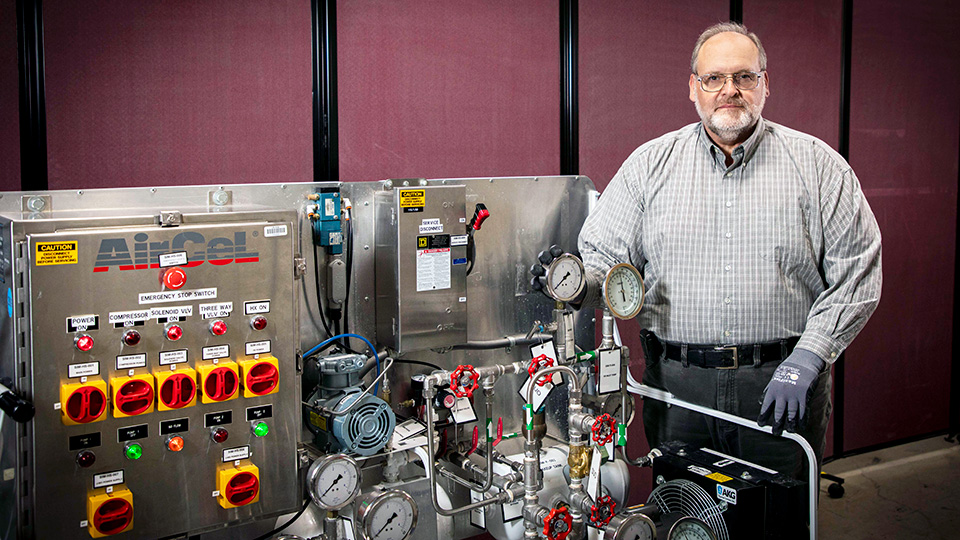
John H.’s colleagues refer to him as the MVP of training. The title is fitting considering he has dedicated himself to continually growing his instructional and training strengths.
“I wanted to be a teacher since the eighth grade,” he explained. John attended Wright State in Ohio, receiving both a B.S. degree in education and a M.E. degree in administration.
He began his career teaching physics to high school students and part‑time to college students at his alma mater in Dayton, Ohio. That evolved into a training job, working for the Department of Energy at the (former) Mound Plant in Dayton. When that plant faced a shut down in the mid‑1990s, he relocated to Tennessee for a contract job opportunity at Y‑12.
John’s scope at that time was supporting a facility restart project. He attributes this project to a major paradigm shift in his training style. “The project was a complete restart, from the ground up. It was essential for us to concentrate on the why behind the technical skills,” he said. “The focus then became adjusting the learning style to help the workers understand the processes, instead of memorizing them.”
John has been a leader in the Production Training organization for more than two decades. He directly supports material operations, but is often sought out for direction regarding other Production organizations. He is the first smiling face that thousands of Y’12 chemical operators have met on their first day on the job.
Simply put, an operator’s objective is monitoring data and remotely adjusting controls as needed to ensure chemical processes function accurately. That is a mission̩critical role in the work performed at Y‑12.
John also supports operational drills and is a certified instructor with the National Training Center.
He sincerely believes in what Y‑12 does and why. “I am proud to be of the generation to replace those who initially built Y‑12. It’s both rewarding and humbling to train and prepare the next generation to take over,” he stated. “I feel very blessed with not only my work but especially my family. My wife and I just celebrated our 44th anniversary!”
What is your favorite aspect about your work environment? How does that aspect make you know the mission is being met?
By far, the personnel with whom I work. I’ve been privileged to work with the finest of personnel throughout my professional career. Now that I am “older,” and maybe a little bit wiser, I wish I could apply more from my prior experiences.
What CNS principle drives you to be successful?
INTEGRITY. Make the right decision for the right reasons. Set high standards.
As an employee, what do you want to be remembered for?
That I did the job the right way, and from the heart.
What work advice would you offer someone who is new to Pantex or Y‑12?
Be patient with yourself, ears and eyes open to old and new ideas. We collectively have a crucial legacy, one that some historians could argue has kept the overall global peace for nearly 80 years.
What one thing would your coworkers be surprised to know about you?
I like to flower garden and work in the yard. Given the odds of winning a big lottery must remain a dream, I would love to have a plant nursery; must be some Frederick Olmsted or Johnny Appleseed genes along the chain.
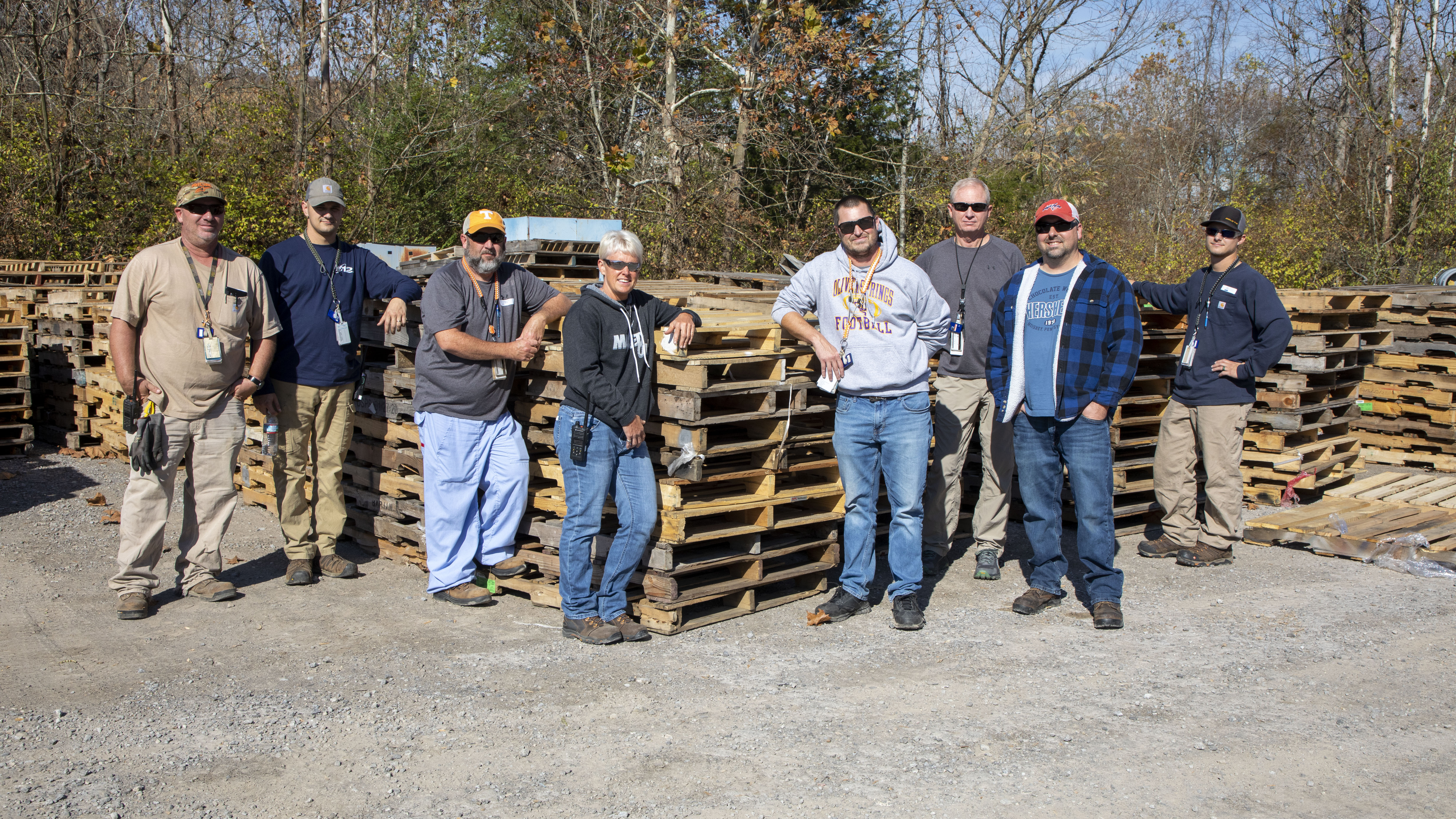
Celebrated annually on November 15, America Recycles Day, also known as National Recycling Day, began in 1994. The day serves to raise awareness about recycling and the purchasing of recycled products. It’s a reminder to all that how we recycle and reuse products is important.
That message resonates with CNS employees, because in Fiscal Year 2023, both Pantex and Y-12 saw substantial increases in recycled materials. While it is a win for the environment, the work also helps support the sites’ national security missions.
Y-12 recycled more than 5.8 million pounds, which is a record number of materials. This exceeds last year’s record amount recycled by more than a million pounds.
The recycling coordinator at Y-12, Lisa B., is encouraged by these achievements. “This means every employee took part in the program. It takes the entire plant doing their part to have such success. Each employee plays an important role. The more we recycle, the more we are able to keep items out of the landfill or items going off-site as waste.”
Pantex recycled more than 1.54 million pounds for FY 2023, which is close to an 8% increase over the previous year.
The intention isn’t simply to recycle more materials, but also to become more efficient in our practices. Alicia B. of Pantex Environmental Compliance notes that her group is working on a new initiative with Waste Operations to get a paper briquette machine. This equipment addition will fast-track the transition of waste paper into functional reusable material.
Sustainability has worked in tandem with Waste Operations to overcome obstacles at Pantex. “To have over 1.5 million pounds recycled this year, and the fact that we have continually been able to increase that number can be attributed to these groups working hard at finding recyclers in the Amarillo area,” she said. Waste Operations administers and manages
multiple recycling contracts through CNS Procurement. It is these contracts that essentially authorize us to offer materials to the recycler and take credit for diverting that material from landfill disposal.
Both sites ultimately attribute success to increased employee awareness and contributions. Adding recycle repositories around the sites has helped make recycling easy and convenient. Technological advances and vendor participation have allowed items to be recycled that would have previously ended up in the landfill or hazardous waste disposal.
“Employees should be proud to be a part of an organization that is so dedicated to keeping as much material as possible from going to the landfill,” said Jeremy P. of Y-12 Sustainability. He added, the goal is to create new material streams every year. This can only continue to foster an environment for recycling success at CNS.
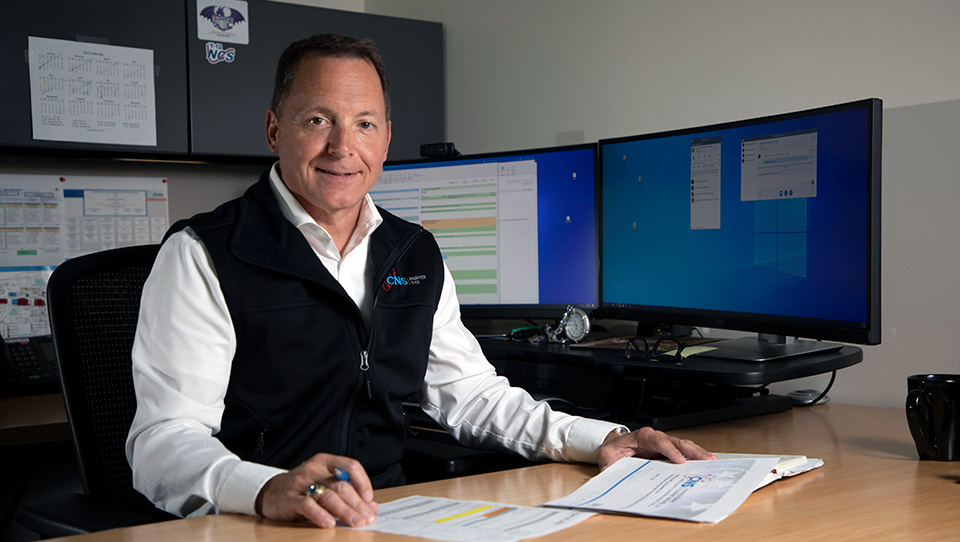
Take 5 minutes to learn about Chris Harkins, CNS chief operating officer. All views and opinions are the employee’s own and do not necessarily reflect those of CNS.
CNS Chief Operating Officer Chris Harkins helps manage daily operations of Pantex and Y-12 and works with President and Chief Executive Officer Rich Tighe to ensure the sites conduct safe and productive operations. When you consider there are more than 13,000 employees working to achieve the mission, that is a large undertaking.
“I’ve been impressed by the massive scope at Pantex and Y-12,” said Harkins, who arrived at CNS in May. To help keep safety and security at the forefront, he also provides oversight for investigations, critiques, and corrective action plans.
“The similarities between these and other sites made for a seamless transition,” he said. “From the safety first culture to our link to the national security mission, the Pantex and Y-12 workforces have a sense of purpose, are professional and proud, and know what they are doing.”
It doesn’t take new CNS employees long to understand the importance of the Pantex and Y-12 mission and feel a sense of pride and patriotism in serving that mission. For Harkins, a U.S. Navy veteran, the patriotism was already well established, but seeing an assembled product ready for shipment at Pantex recently, he felt added pride.
“Standing next to and seeing the final assembled product [at Pantex] waiting to be shipped to the Department of Defense was surreal,” he said. ”The Pantex workforce is extremely competent, and that is really important in this line of work.”
He has similar thoughts about Y-12. “I’m amazed at the employees’ expertise on uranium and other special materials and how the site is its own self sufficient manufacturing plant.”
The communities around both sites intrigue Harkins, thanks to a childhood hobby.
“I really enjoy watching the trains in the Amarillo area on the way to and from the site (I was a model railroader growing up),” Harkins said. “In Oak Ridge, it’s the historical aspect and the fact that the activities of the secret city of Oak Ridge were actually kept secret until the time of our choosing in 1945.”
As a U.S. Navy veteran, you likely are more familiar than most people with the mission of Pantex and Y-12. How has working for CNS changed or reinforced your thoughts on our mission (nuclear deterrence, managing the stockpile, etc.)?
My first exposure to nuclear weapons in the Navy came late in my career when I was assigned commander of the Atlantic fleet’s nuclear ballistic missile submarine [known as SSBN] squadron in Kings Bay, Georgia. As commodore of the SSBN squadron, I was responsible and accountable to the U.S. Strategic Command and the U.S. Navy for the readiness of our SSBNs (crews and equipment) to execute strategic missile launch tasking if directed. It didn’t take me long to gain immense respect and admiration for the exacting standards maintained by the SSBN force.
Today, having worked at Savannah River, Los Alamos National Laboratory, and now Pantex and Y-12, seeing the production end of the weapons programs brings an even greater respect for the entirety of the team behind our nation’s successful nuclear deterrence capability.
What daily task (specific meeting, report, etc.) lets you know you’re helping achieve the CNS mission? How/why does that task let you know you’re working toward the mission?
In the Navy, it was the ability to keep the required minimum number of SSBN submarines (and their warheads) at sea and/or trained/ready/available to meet national security requirements. Here at CNS, the most important metric is the ability to safely meet our warhead and bomb production rates so that our delivery platforms [bombers, ICBMs (intercontinental ballistic missiles), and submarines] actually have the number and types of nuclear weapons required by our national strategy. That’s why I believe it is so important for every employee to see a clear connection between what they do in their everyday job and how it directly contributes to our national security.
What is your favorite aspect about your work environment? How does that aspect make you know the mission is being met?
My favorite aspect about my work environment is the ability to leave my office and go to the shop floor or into the field to engage the team. I am a big believer in getting out and about and engaging employees in their workspace.
I have yet to meet a CNS employee not eager to talk about what they do, share their accomplishments, and even more important for us as leaders, tell me how I can help them. Putting “eyes on target” is a very informative tool and enables the leadership team to maintain confidence that the mission is being met.
What top strength do you bring to your organization and why?
Towards the end of my Navy career, I became an expert in human factors analysis, specifically why smart, trained, and qualified people sometimes make bad decisions, the most significant of which could end up costing hundreds of millions of dollars and/or causing fatalities. Having a good understanding of decision making under various conditions and cognitive biases is essential to the prevention of errors, but that alone is not enough. Getting organizational buy in in this area and implementing the right processes and culture is much harder, but I have had the pleasure of leading it at several organizations. It is exciting to watch an organization become a genuine “high performing organization,” because the ultimate winners are the organization’s employees. If you have ever been on a winning team, you know what I am talking about — it inspires you to be even better and seek ways to improve yourself and your organization each and every day.
What’s your favorite outside of work activity and why?
I love the outdoors and staying active: fishing, boating, and relaxing at our lake house. I also enjoy hiking.
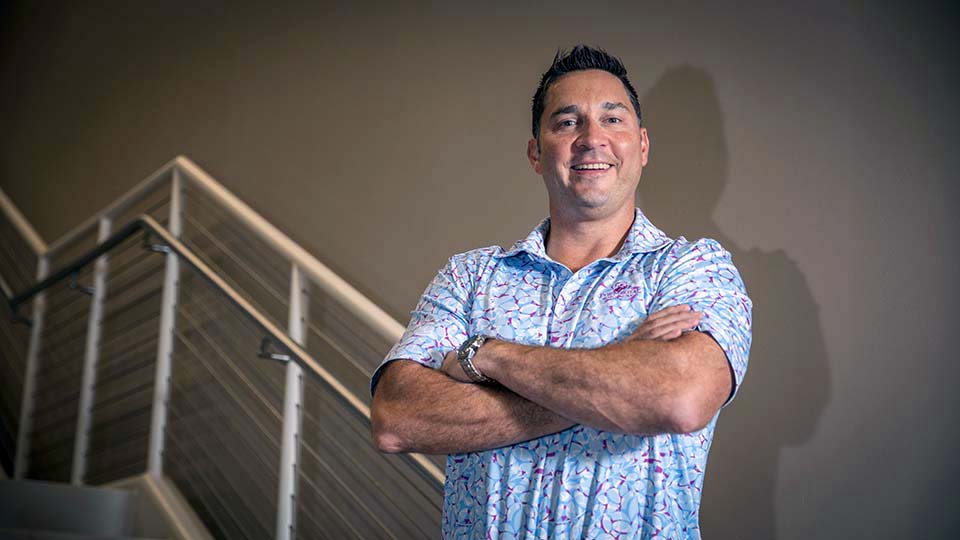
It isn’t often a coworker will have extra pairs of socks on hand at work. Having socks may sound weird, but if you walk from a Y‑12 east‑end parking lot to the west end of the plant during a downpour, having extra socks when you (or a peer) start the day comes in handy. “No one likes to walk around in wet socks and shoes,” Michael M., owner of the extra socks, said. “When I was production, I had extra socks to offer my team if they had trudged in through a heavy rain. Now I feel like I’m cheating when I can park outside my building and get to my office without the long walk and my socks staying dry.”
While he is in a different job now, that compassion for his team is something that remains as he leads the Y‑12 workstream for Site Separation Management. “I’m here to prevent distractions to all Y‑12ers in terms of site separation,” he said. “I’m sensitive to what employees are feeling. The main goal is our employees continue to be successful in their role whether they are at Pantex or Y‑12.”
Why are you mission success?
I am a part of mission success because site separation is crucially important to our customers and the government at large. It took many years for Pantex and Y‑12 to become one entity, and to separate the sites back out into two stand-alone sites is cumbersome. Completing site separation the right way is important and will emphasize how strong the mission of each site is.
As an employee, what do you want to be remembered for?
I want to be remembered as an employee who cares about the Y‑12 mission and the people who execute it. I’ve had the privilege of managing more than 200 people during my years at Y‑12. The least I can do for those who make sacrifices to meet the mission is to fight for their advancement and help them be a success day‑to‑day.
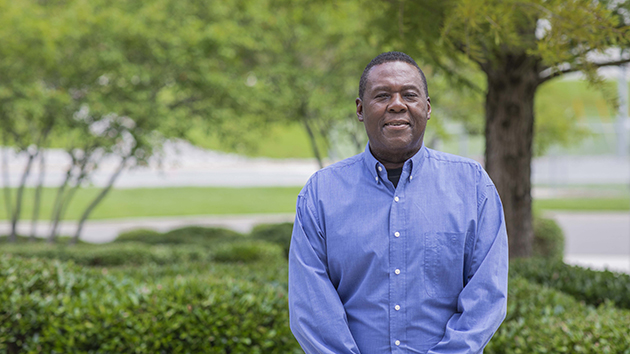
Take 5 minutes to learn about Emmett Wade, fabrication and production support manager at Y‑12. All views and opinions are the employee’s own and do not necessarily reflect those of CNS.
When Emmett Wade received a layoff notice in 1982, the then‑Y‑12 machinist kept the faith.
“There were approximately 1,300 machinists working three shifts,” he recalled. “The work slacked up, and I got a pink slip. Management was trying to place everyone they could. I was offered janitor and guard jobs, but I held fast. I prayed about it and prayed about it. I kept thinking God has something else for me.”
Wade was soon offered a machine technician position in Assembly at Y‑12, which came with a one‑cent raise. Several positions at the site followed over four decades, including his current role of fabrication and production support manager.
“People don’t realize what it takes to get a part moved from building A to building B,” Wade explained. “You have to take in account all of the ES&H [Environment, Safety, and Health] concerns with the material and the security concerns, including classification.”
In addition to the complexity of the material movement is the demand for the service. “If one person wants something moved, there are several other people that want something moved, too,” Wade said. “We are always busy.”
Helping Wade keep tabs on what material is moving throughout Y‑12 are material controllers and material clerks, who he manages. Controllers perform “clockings” of material from one area to another, which establishes control and accountability when material is handled at each location. Clocking data includes weight, description, classification, and other details. Material clerks are hands‑on, picking up the material and moving it throughout the facility. Also, clerks do part markings, which provide important identification and verification for weapons components.
“You can have several hundred parts in one storage area,” Wade said. “We dig our way through to find what they need. You never know when someone will have a need for a certain part. We have parts that are 25 years old or older.”
“I’ve been doing this a while, so I’m pretty good at it,” he said. “I definitely know the territory.”
What is your favorite part or aspect of your work environment? How does that aspect make you know the mission is being met?
The accomplishment of getting the material where it needs to be in a timely manner. They will say, hey we appreciate you getting that part to us. This helped us make our deadline.
How does patriotism factor into your life? Did your level of patriotism change after working at Y‑12?
I had to learn that over the early part of my career. As a 19‑year‑old kid, you are just happy to have a job. I didn’t understand the whole method of what we were doing, but later I learned where these parts actually end up — on ships, planes, weapons for the military. The components we move are used in defense of our country.
What’s your favorite outside‑of‑work activity and why?
I have officiated football, basketball, and volleyball games at middle schools and high schools for 35 years. Participating in these activities, you have to have a high tolerance for people calling you names, yelling at you. This has helped me to be a patient person here at Y‑12, where I have to deal with all these requests coming in and with all of these different personalities and attitudes.
What work advice would you offer someone who is new to Pantex or Y‑12?
Gather as much knowledge as you can in every job. Not many people stay in the same job for the life of their career. What you learn in the first job will help you in the second job, the third, and so on. This will help you at each stage of your career.
